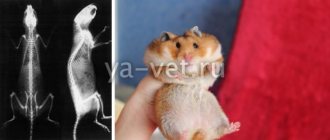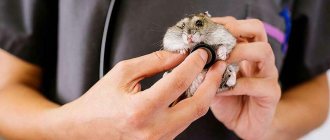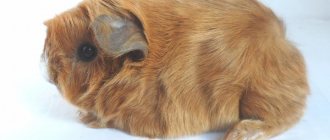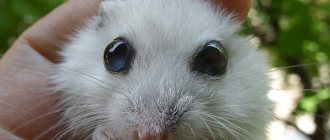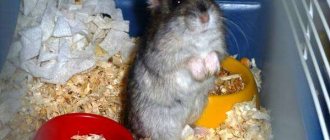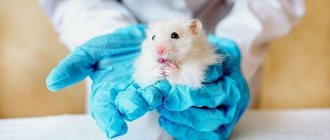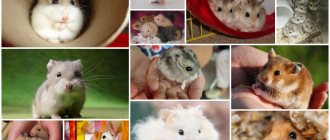Skin disease is an ailment that is often found among pet hamsters. The most common are allergic dermatitis, baldness and lichen. Ringworm refers to a group of dermatological rashes that have different etymologies, mainly viral, and appear in the form of red sores. One area of skin or several may be affected, and the skin at the site of the lesion becomes bald, itchy, and scabs appear. Ringworm most often occurs in hamsters with a weakened immune system, after stressful situations or with chronic diseases. At the slightest suspicion of lichen, you should seek help from a veterinary clinic.
Varieties
Most often, two types of lichen occur in hamsters: ringworm and pink lichen.
Ringworm refers to two separate diseases - trichophytosis and microsporia. Hamsters are susceptible to microsporia. It has a long incubation period, which can last a month or more. This is an infectious disease in which round, flaky areas appear on the body, as if cut off, with hair broken at the base. They become inflamed and turn into ulcers with the release of pus and the formation of a dense crust. This is clearly visible in the photo.
The disease affects the muzzle, behind the ears or sides. Constant scratching causes the infection to spread throughout the body. It is quite difficult to cure such lichen. It is easily transmitted, and a person, especially a child, can get it.
Pityriasis rosea is caused by a viral infection. It appears on the body in the form of multiple pink dots, which can be 1.5-2 cm in diameter. The disease can last up to 40 days. The cause of the appearance is considered to be the weakened immunity of the hamster. Most often, weakened rodents, elderly or, conversely, young, suffer from this disease. The disease can be seasonal, appearing in the spring and autumn, when the hamster’s body suffers from vitamin deficiency. Therapy should be aimed, first of all, at increasing immunity. In some cases, your veterinarian may prescribe antihistamines. Ringworm is not contagious. Its causative agent is still unknown.
There are other types of lichen, but hamsters are not susceptible to them. However, any type of disease can develop on the skin of an animal that is not typical for itself. Therefore, only a specialist can recognize the disease and prescribe the correct treatment.
Ringworm
A specialist will quickly determine what happened to your pet. There are two types of hamster lichen. It's pink or haircut. They have a different course, so it will not be difficult to make the correct diagnosis. Let's look at the distinguishing features. It is important that the owner himself understands what is happening to the pet and can seek help in time.
Ringworm in hamsters can be caused by two reasons: trichophytosis and microsporia. Rodents are susceptible to microsporia. This is an infectious disease that can be dangerous for its owners, so do not waste time and seek help immediately.
Signs of the disease
Most often, ringworm is diagnosed in hamsters. Both an adult and a young hamster can get sick, but, as a rule, young animals get sick more severely and seriously. This is due to imperfect immunity, nutritional deficiencies, and viral infections. Breeders often wonder where a pet animal can get this disease if it does not leave the apartment. It turns out that the virus is transmitted not only from a sick animal, it can be brought into the house by a person from the street on shoes or clothes. If the hamster's immunity is reduced, it is sick, or there is damage to the skin, this can cause rapid infection. Fungal spores are very stable and can remain on the hair throughout life, so the cage, drinking bowl and feeder are also contagious.
The fungus, when it gets on the skin, penetrates the tissue, multiplies quickly, and releases toxins. They are the ones that cause itching and inflammation of the skin. The infection destroys the hair structure, causing baldness of the infected area of the skin.
Diagnosing the disease at home is difficult, because hair loss, baldness or itching may not necessarily indicate the appearance of lichen. In this way, allergies to food, parasites, mites manifest themselves, and hair loss can be associated with baldness. Therefore, it is so important to seek advice from a specialist in time and not to independently treat the animal. The veterinarian will scrape the damaged areas of the skin, conduct a laboratory test (examine the hamster with a Wood's lamp, which, if ringworm is present, shows a green glow) and prescribe the appropriate type of treatment. In any case, when lichen appears, the following symptoms occur:
- spots on the skin of different shades;
- rash;
- peeling;
- skin itching;
- hair loss;
- restless or aggressive behavior;
- refusal to eat.
If you notice the presence of any strange scabs on your pet’s body, immediately contact a veterinary clinic, because an infectious disease is dangerous not only for the animal, but also for your family.
general description
The most popular skin ailments are allergic dermatitis, baldness and lichen. At the same time, lichen in hamsters is not a specific disease, but a whole group of rashes that have a different nature, mainly viral. Appears as red sores on the skin.
The lesion can be localized or spread over a large area of skin. At the same time, the skin becomes bald, itches, and scabs appear on it. Most often, lichen in a hamster develops in case of decreased immunity, after stressful situations or in the presence of a chronic disease. At the slightest suspicion, you should immediately contact a veterinary clinic.
Treatment
As a rule, hair is completely removed from the affected areas. This way you can get rid of spores that are on the fur. It is best to burn cut hair. The cage, drinking bowl, feeder, and all accessories must either be disinfected or replaced with new ones. The animal must be isolated from other pets, if any. You can only touch it with gloves. Quarantine must last at least one month.
The following treatments are prescribed: ointments, antibiotics, shampoos, solutions, vaccines, tablets, immunostimulants.
If the veterinarian has prescribed antifungal agents, then the rodent needs to be treated completely, and not just the inflamed areas, because with constant scratching, fungal spores quickly spread throughout the body. In this regard, ointments against fungus help only in complex therapy, because it is completely impossible to smear them on a hamster. Not only local treatment, but systemic treatment is required. It involves taking antifungal medications orally. Treatment of the disease should be carried out until complete recovery, which is approximately two or three months. After the scabs on the body disappear, the pet should be shown to the veterinarian again and undergo a full range of tests. Only after this can he be considered healthy.
What infections are contagious to humans?
Scab, ringworm and dermatophytosis have a detrimental effect on the human body, causing almost the same symptoms as in animals. Therefore, if you are treating your pet at home, you need to protect yourself and all family members. Be sure to wear disposable gloves when performing treatment procedures. Objects that the sick animal has come into contact with must be treated; if possible, it is better to boil them.
People with weakened immune systems and prone to frequent stress are often susceptible to these infections; children most often suffer from dermatophytosis.
Diagnostics
An infection can only be diagnosed by taking tests in the form of scraping from the affected areas to determine the fungus.
Prevention
The breeder should be aware that lichen can become a chronic disease and haunt the pet for the rest of its life. To prevent or exclude cases of a new relapse, it is necessary to constantly maintain the rodent’s immunity. To do this you need:
- Provide proper nutrition. The basis is a feed mixture, as a supplement - vegetables, fruits, nuts, herbs. Be sure to give your baby food rich in protein: fish, chicken, low-fat cottage cheese, worms, grasshoppers (the latter can be bought at a pet store). Make your animal's diet so that it is balanced.
- In the autumn and spring, when the body is susceptible to vitamin deficiency, give your pet vitamins. They can be purchased at any veterinary pharmacy. Give as many greens and berries as possible.
- Monitor your pet’s health and promptly treat any disease that affects it.
- Vaccinate your hamster. Vaccinations help develop immunity and protect against major serious diseases.
- Make sure there is always clean drinking water in the drinking bowl. Change it daily.
- Maintain good hygiene. Do not take your pet outside, do not take it to the countryside, and do not allow it to come into contact with others, especially homeless animals.
- As a last resort, you can resort to vaccination against lichen. True, many veterinarians believe that it is useless, since it retains its properties only during the first months. In addition, the hamster’s body does not tolerate it very well, and after vaccination the fungus becomes more resistant to some antiviral drugs. It is up to the breeder to decide whether to resort to this type of therapy or not.
Remember, lichen is a very complex viral or infectious disease that can constantly haunt your pet. It is dangerous not only for pets, but also for humans. It is easier to prevent lichen in hamsters than to treat it throughout its life.
How to treat at home
Before treatment begins, the sick animal is isolated from other pets, all objects with which it has been in contact are disinfected or disinfected and replaced with new ones. It must be taken into account that you cannot simply throw away a cage or feeder - they are contaminated with a pathogen and will be dangerous to other people and animals.
Important! Triderm is the main complex antifungal drug used for various skin pathologies. Apply externally for 10–14 days
Apply a thin layer to the affected areas after disinfection 2 times a day.
Treatment should be systemic (support of the body) and local (treatment of lesions). The lesions are treated with iodine solution and salicylic ointment. Iodine disinfects the surface, and antibacterial ointments help restore it. The hairs in the affected area are first removed, as they are infected with fungal spores. If there are crusts, they must be softened and removed. The duration of treatment is at least 30 days, until the symptoms of the disease disappear. Internally, agents are prescribed that support the immune system and restore the microflora.
The medications are prescribed by the doctor, depending on the type of fungus that has infected the animal. This takes into account the weight of the hamster and the degree of infection. Do not experiment with treatment. Trust the prescription of the course and determination of dosages only to a specialist.
Hair removal
The hamster needs to be handled on oilcloth or other surface. After processing, equipment (scissors) must be boiled for at least 10 minutes to destroy fungal spores. It is imperative to work with gloves; the surface of the table on which the procedures are carried out is covered with disposable oilcloth, which is then destroyed along with the hairs, since they contain fungal spores. When working with a sick rodent, gloves must be worn. All potentially infectious objects used during the treatment of a hamster must be worn. must be stored out of the reach of children. It is imperative to ensure their complete isolation from direct contact with other objects.
Disinfection of housing and equipment
If you have a quartzizer, it is necessary to treat the room for 20–25 minutes daily. Clothes are washed using white. Soft surfaces (sofas, armchairs, carpets) are sprayed with chlorhexidine vapor.
Floors, walls, doors and other surfaces are treated with an aqueous solution of bleach in a ratio of 10:1 or another disinfectant that has antibacterial properties.
Antiviral and antifungal drugs
Medicines that suppress the activity of fungi are called antimycotics. Their action is aimed at destroying the fungus or preventing the proliferation of spores.
Important! Injections are given to the hamster subcutaneously at the withers with an insulin syringe. Before manipulation, the injection site is treated with alcohol
Intramuscular injections are performed into the muscle of the hind paw.
Antifungal drugs are not universal and act on certain types of fungi, therefore they are prescribed only after the type of fungus has been determined by a doctor:
- Fluconazole - inhibits the synthesis of fungal spores. To treat lichen, a course lasting 2–4 weeks is prescribed. Use once a day in the dosage prescribed by your doctor.
- Griseofulvin - intended to prevent fungal cell division. Since the drug is an antibiotic, it is not prescribed for prevention, but only for treatment.
- Ketoconazole - stops the synthesis of cell membrane substances, destroying the fungal membrane. This is a broad-spectrum drug. The course of treatment is 10 days. Can be used for both treatment and prevention.
Causes of hair loss
They can be divided into two categories: natural and pathological shedding.
The pet is healthy, active, eats well, but the fur is very loose.
Seasonal shedding - old wool is replaced by new. Occurs intensely on the abdomen and the inside of the legs, and almost imperceptibly on the back.
Age - on average, hamsters live three years, a two-year-old rodent is already considered old, and it is quite natural that he began to go bald.
Hormonal changes – during pregnancy, females can experience intense hair loss. Also, bald spots on the abdomen appear in hamsters that feed their young.
Sometimes hair loss can indicate health problems or improper care. The causes of baldness should be excluded and checked in order:
Filler - some of them can cause an allergic reaction in a rodent.
Nutrition - it must be balanced with all the necessary elements so as not to cause vitamin deficiency. Sometimes hamsters develop intolerance to some fruit or vegetable, it is worth finding out by elimination.
Stress – constant change of environment can lead to baldness.
Diseases are one of the most dangerous causes. Only a specialist can make a diagnosis and prescribe effective treatment.
Types and symptoms
Do hamsters get shingles? A domestic hamster can also become infected with a dangerous skin disease. Most often, lichen is of viral origin and manifests itself as red sores on the skin of a rodent. There can be from one to several affected areas. In these places, in addition to baldness, scratching and scabs are observed.
It is believed that weakened hamsters with a history of some kind of chronic disease are most susceptible to deprivation. Reduced immunity, as well as stress, contribute to the occurrence of this skin disease.
Pink
Most often, hamsters are affected by two types of lichen - pink and ringworm. Existing other species of these rodents are “not touched.”
Pityriasis rosea is caused by a viral infection. By the way, the causative agent of the disease has not yet been identified or identified. This type of lichen is not contagious. Both older and very young animals can get it if they have a weakened immune system.
The animal's body is covered with many pink spots - even up to two centimeters in diameter. The duration of the illness can be up to one and a half months.
Hamsters get sick with pityriasis rosea mainly in the spring-autumn off-season, when vitamin deficiency cannot be ruled out. It is logical that treatment is aimed primarily at strengthening the immune system. Sometimes antiallergic drugs are prescribed.
Shearer
What does lichen look like in a hamster? Ringworm - the name alone speaks of its “character”. In turn, such lichen is divided into two different infectious diseases, one of which - microsporia - can affect hamsters.
How can a pet hamster become infected with ringworm if it has not had contact with a sick animal? The pathogen can be transferred to the clothes or shoes of a person who came from the street. And if the pet’s body is weakened or there is damage to the skin, then infection occurs very quickly.
By the way, the disease may not appear soon from the moment of infection: its incubation period is often a month or even more. First, round bald spots appear on the rodent's body - they seem to have been sloppily trimmed: the hairs look broken at the “root”. Then these places become inflamed, turning into purulent ulcers, which then dry out and form a dense crust on the skin.
One of the symptoms of the disease is itching. The infection penetrates deep into the tissues, quickly multiplies, releasing toxins that cause inflammation of the skin and itching. This disease affects:
- muzzle,
- behind the ears,
- sides of the hamster.
And constant scratching of the affected areas helps spread the infection to other areas.
Is it contagious to humans?
The hamster refuses to eat, behaves very restlessly and even aggressively.
In dungarian hamsters, the causative agent of lichen is the fungus trichophytosis. A pet can get sick at any time of the year, but in hot summer weather there is a decrease in incidence.
Dermatophytosis
A skin disease caused by dermatophyte fungi that feed on hair and dead cells. The infection is also known as ringworm because the red lesions appear in rings on the skin.
There is severe peeling along the edges of the spots, while the surface in the center is absolutely healthy.
Dermatophytosis poses a threat to households - it can be transmitted from animals to humans.
Treatment is selected by a specialist, usually using external agents such as Yam or Fungin ointment, Zoomekol aerosol, chlorhexidine, and sometimes oral medications. The duration of therapy is 1-2 months.
Don’t forget about disinfecting the premises – fungal spores are viable for up to 4 years.
Medicines for diseases in hamsters
Remember that a number of medications are dangerous for hamsters, and their use can lead to death. Antibiotics dangerous for hamsters include:
- penicillin
- ampicillin
- erythromycin
- gentamicin
- lincomycin
- cephalosporins
Never use an antibiotic without your doctor's advice.
To prevent any disease in hamsters, follow sanitary and hygienic rules, such as regular cleaning and disinfection of the cage, preventing contact with sources of disease, as well as adequate feeding and optimizing the hamster’s living conditions.
Scab
This is a viral disease characterized by the appearance of a white coating on the affected areas. A scaly plaque forms on the ears, tip of the nose, and eyebrows, which over time becomes covered with gray blisters. They have a round shape, the diameter is constantly increasing. After some time, a crust with remnants of animal hair appears on the wounds. Scab is especially active during the warm period - spring and summer. The incubation period lasts about two weeks. A hamster can become infected with this disease through contact with sick animals, from insect bites, through contaminated cage litter and food.
Treatment of the animal should begin with cleansing the affected areas. To do this, the scabs must be softened with oils or fats. Then the foci of infection are treated with an alcohol solution with the addition of salicylic acid and iodine. The procedure must be repeated several times a day until the animal is completely cured.
During treatment, it is necessary to isolate the hamster from other animals, as this disease is very contagious. The rodent's cage, toys and bowls must be disinfected with special means. Once you have isolated the animal, change the bedding to pine sawdust and thoroughly clean the floors. The room where the animal's house is located must be well ventilated.
